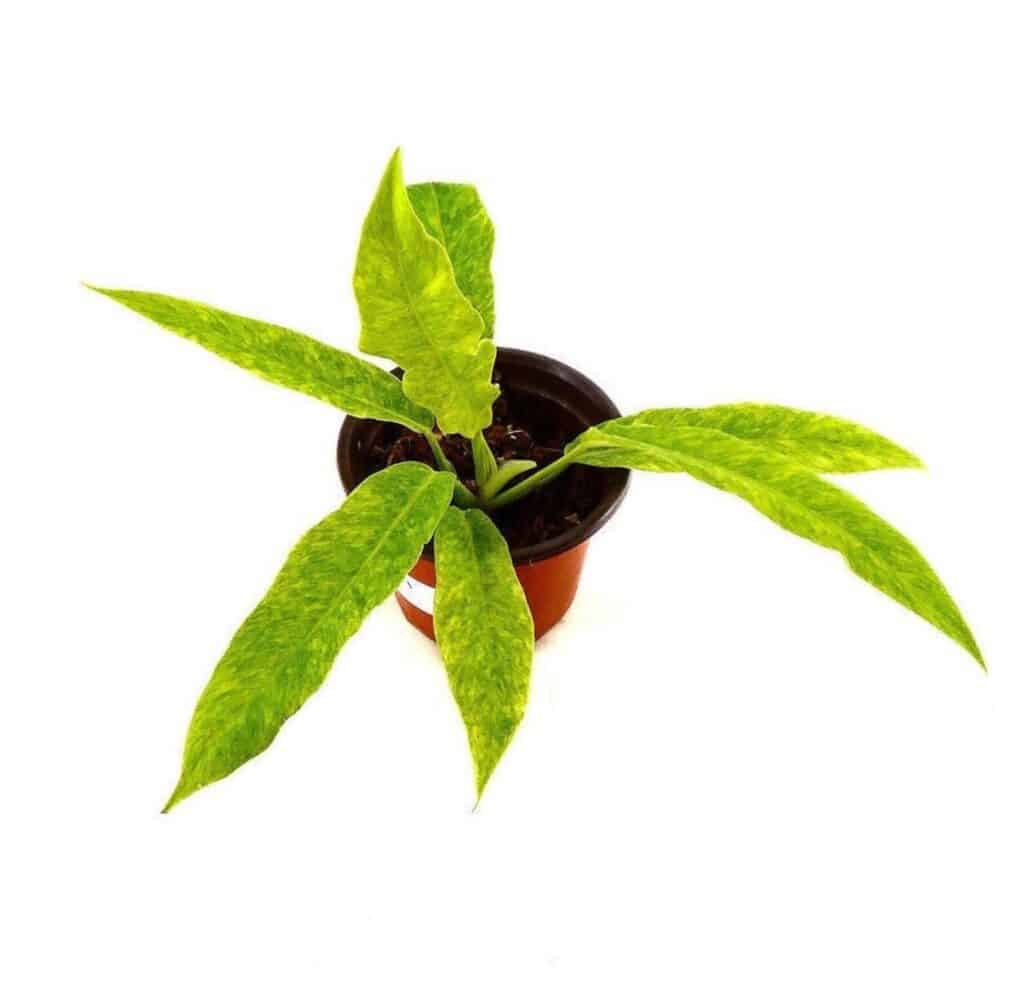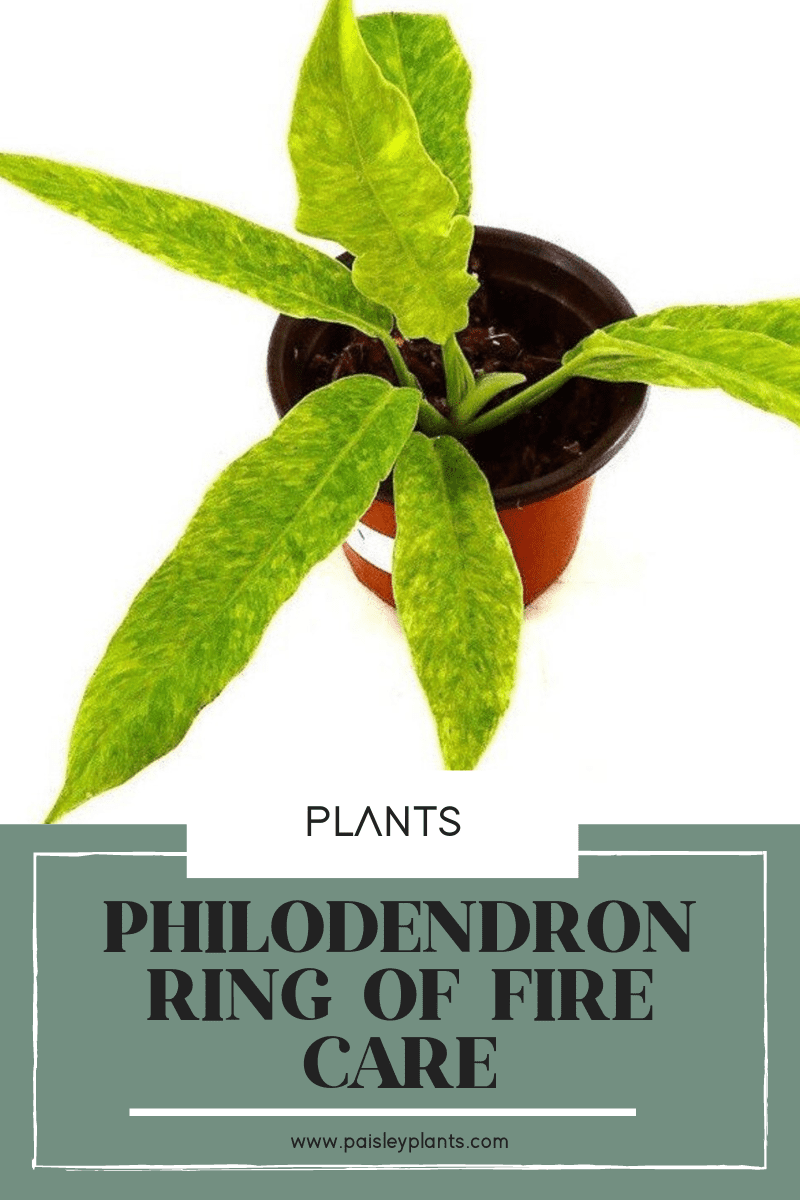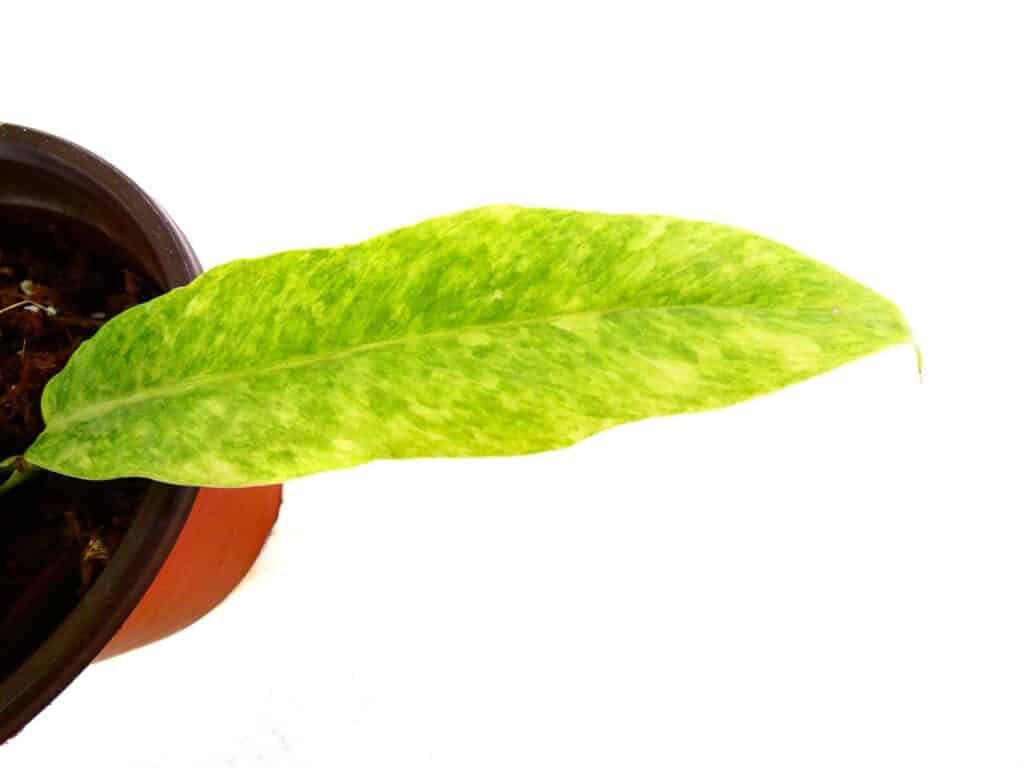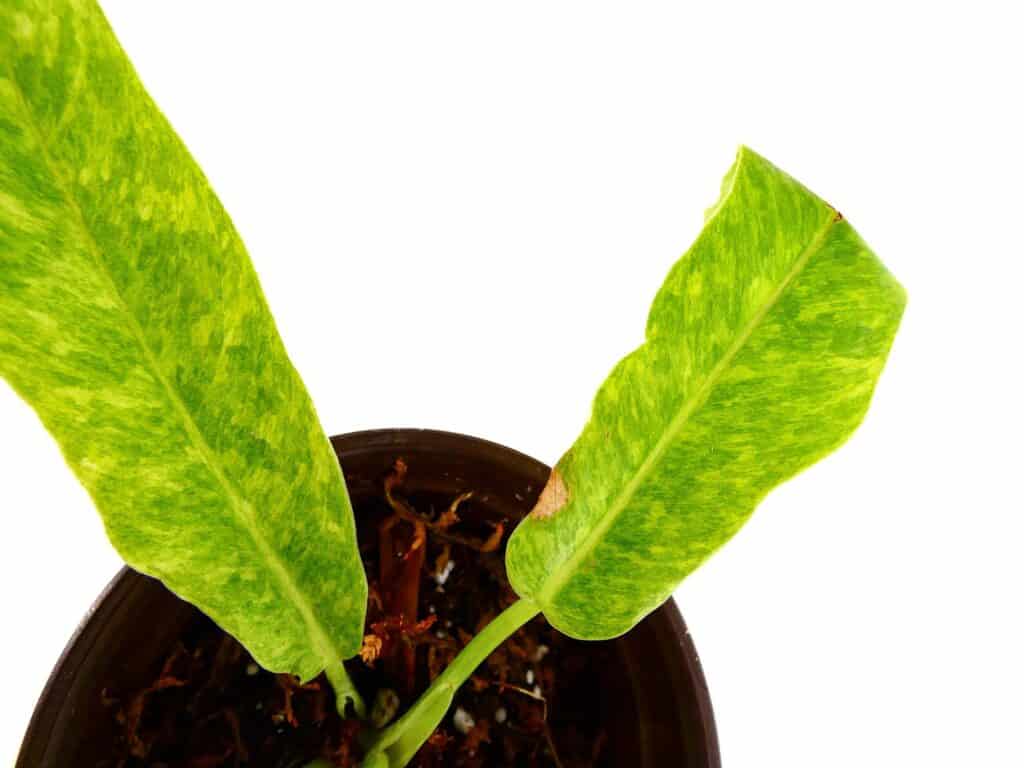If you’re looking for a rare and exciting philodendron to add to your plant collection, look no further than the Philodendron Ring of Fire.
Read on for this ultimate care guide on how to successfully grow this beautiful variegated philodendron hybrid.
Table of Contents
Philodendron Ring Background

Image via Beleaf Tropicals
This post includes affiliate links.
Native to the region of Central and South America, the Philodendron Ring of Fire is one of the rarest varieties of philodendron. The ring of fire is the hybrid of the Philodendron wendlandii and Philodendron tortum.
As you could probably tell from its name, the Philodendron Ring of Fire is identifiable by its long, serrated leaves. These leaves are variegated in a wide variety of hues, ranging from red, orange, yellow, white, and even pink.
At full maturity, these plants can grow to a staggering height of up to 8 feet tall!
Like all other philodendrons, the ring of fire is unfortunately toxic to humans and pets. Consumption of this plant can cause severe mouth and esophageal irritation.
We highly advise plant owners to exercise caution when keeping this plant near children and animals.
Find non-toxic pet friendly plants here!
Philodendron Ring of Fire Growing Preferences

Sun & Light
The Philodendron Ring of Fire is very forgiving of multiple light conditions. However, for the best results, it is recommended for fire plant care that you provide your Philodendron Ring of Fire with bright, indirect sunlight.
Each plant will vary somewhat in the amount of light it likes, but generally, these plants prefer bright, indirect light.
If you cannot adequately provide those light conditions, then don’t worry, the ring of fire can also grow well in partial shade conditions. Just make sure your Philodendron Ring of Fire is not placed in direct light.
Soil Type
The best soil for a Philodendron Ring of Fire is one that is well-draining, moisture-retentive, and organic. We recommend selecting an aroid potting soil mixture for this particular plant. Aroid potting soil mixes usually contain materials such as peat moss, orchid bark, perlite, and charcoal.
The chunky materials in an aroid mix will allow for optimal airflow in between the roots, while the absorbent ingredients will help retain moisture in order to nourish the plant’s roots.
Water
The Philodendron Ring of Fire prefers to have a moist (but not too wet) soil. As a good rule of thumb, we recommend waiting until the top few inches of soil has dried up; on average, you’ll find it best practice to water your plant every 7 to 9 days.
During the cooler months (when the plant’s rate of growth slows), you can decrease the frequency of your waterings. We recommend giving your Philodendron Ring of Fire water about every 2 to 3 weeks during fall and winter to encourage growth.
Getting the perfect balance between too wet and too dry soil depends on the air temperature, humidity, and the amount of light that your plant gets during the day
Fertilizer

Image via Beleaf Tropicals
While the ring of fire does not require a frequent fertilizer routine, feeding your plant a few times a year is enough to encourage healthy, vigorous growth in your plant.
There are a number of fertilizers on the market that are specially tailored to the growth requirements of philodendrons.
Follow the directions on the package and apply an even layer of the fertilizer to your plant three times during spring & summer. We recommend fertilizing your plant just after watering it, as the water helps the plant absorb the nutrients easier.
Do not fertilize your philodendron during the fall and winter. During this time, your plant is in its dormant period and does not want or need extra nutrients.
A build up of unnecessary fertilizer in your Philodendron Ring of Fire can acidify the soil to an uninhabitable pH level.
Temperature & Humidity
Despite being a tropical plant, the Philodendron Ring of Fire adapts well to normal household temperatures and humidity levels.
Your philodendron will grow and thrive in an area of the home that has temperatures between 55° and 80° F, which is more than attainable for the average plant owner.
The Philodendron Ring of Fire does not fair well in cold temperatures or fluctuating temperatures. With higher temperatures, your plant will grow slower, get dehydrated quickly, and will require more care.
Maintaining good humidity level also shouldn’t be a difficult task in your plant care routine; try to keep the humidity level around 50% and above.
If you live in a dry climate and have worries about the humidity in your home, then it is always helpful to keep an air humidifier nearby for your philodendron plant.
Philodendron Pruning & Maintenance

Image via Beleaf Tropicals
Pruning your ring of fire plant does not require a set schedule and can be done at any time of year. It is also always recommended to prune any parts of the plant that have become damaged over time.
Sometimes, a ring of fire can have an unkempt or overgrown appearance if the leaves are allowed to grow freely. In this case, feel free to trim off some of the leaves to control your plant’s size and shape.
Choosing a Container & Repotting your Philodendron
Like many other philodendrons plants, the ring of fire benefits greatly when placed in a pot with good drainage. Having at least one drainage hole at the bottom of your pot will best help the plant expel unnecessary moisture, keeping the soil comfortably moist.
A lack of drainage is one of the primary causes of fungal-based diseases in your plant’s soil.
The Philodendron Ring of Fire is also a climbing plant and benefits from being given a moss pole to climb. Alternatively, many plant owners like to plant their ring of fire in a hanging basket and let the leaves hang over the edge to continue growing.
You won’t have to worry about yearly repotting of your Philodendron Ring of Fire. In fact, the ring of fire actually prefers to be slightly root bound.
Expect to repot your philodendron approximately every two years. When repotting your plant, it is very important to size up your pot very gradually, opting for the next size up to give your Philodendron Ring of Fire room for growth.
How to: Propagate Philodendron Ring Plant
The Philodendron Ring of Fire can easily be propagated by using stem cuttings. Propagating your ring of fire is a great idea after pruning your plant; follow these steps to learn more on how to propagate philodendron ring:
- You’ll need a stem from your plant that is healthy and at least 7 or 8 inches in length; multiple nodes are extremely helpful in increasing the odds of rooting and growing.
- Prepare a small pot or propagation station filled with moist potting mix and set it aside.
- Dip the cut-end of the stem into rooting hormone powder.
- Transplant the stem into the soil. Make sure that all the leaves are above the surface of the soil (this allows for airflow and decreases the odds of root rot).
- Place the pot in a location that receives bright, indirect light. Avoid direct light entirely.
- It could take about a month for rooting to occur in the plant. To check, give the stem a little tug; when you’re met with resistance, then that means the plant has rooted!
- Continue to care for your plant as it continues growing, especially in the first months. At this stage, the juvenile plant is most susceptible to disease and rot.
Common Philodendron Pests
Commons pests that are associated with the Philodendron Ring of Fire include mealybugs and thrips. Both of these nuisances are sap-sucking insects; they latch onto the foliage of the plant and suck out the nutrients.
An infestation of pests can cause your Philodendron Ring of Fire to suffer greatly. Common symptoms of a pest infestation include pale, yellowing leaves that wrinkle. Mealybugs are also known to leave behind a sticky cotton-like residue on the leaves.
While these pests are a pain to have in your home garden, we’re fortunate that there are solutions you can take to control these problems, and some of these methods can be found in your home!
You can clean off the mealybug residue (and also deter the mealybugs themselves) by wiping your plant with rubbing alcohol. In addition, spraying your Philodendron Ring of Fire with soapy water can stifle the bugs and knock them out for good.
We also recommend investing in neem oil. Neem oil is a natural horticultural oil that is a natural insecticide and fungicide.
Spraying your plants every few days over the course of a week can help totally wipe out your growing pest problem and prevent them from coming back.
Common Philodendron Diseases
As we’ve discussed in earlier sections, the philodendron ring prefers to live in soil that is moist, but not soaked in water. For this reason, we place a heavy emphasis on good drainage and proper watering.
Failure to do so can increase your plant’s risk of developing root rot. Root rot causes the foliage to wilt and die off.
While root rot can be a scary thing to discover in your Philodendron Ring of Fire, there are methods you can take to remedy this disease.
Follow these simple steps to help alleviate your plant’s root rot:
- Gently remove your philodendron ring plant from its pot and shake the excess dirt loose to view the roots.
- Rotted roots are black and mushy in texture, as opposed to healthy roots which are light and firm.
- Using a sterile pair of pruning shears, cut away any roots that appear to be rotted on the plant.
- When all signs of root rot have been pruned, repot your plant in a cleaned out pot (with drainage holes!) and use fresh, new soil.
- Keep the soil lightly moist for the next couple weeks to reduce shock.
Where to Buy
The ring of fire philodendron is truly a unique plant to have in your home. With its vibrant variegation and low-maintenance care, it is no wonder why this rare houseplant is so sought-after by plant collectors of all skill sets!
FAQ
Yes, the philodendron ring is indeed considered a rare plant. For this reason, it may be difficult to find this plant at any big named brand garden retailers. If you are lucky enough to have a local rare plant seller, definitely reach out and ask if they have any ring of fire philodendrons.
Otherwise, there are many online sellers such as Etsy where you can place orders for a plant of your own.
Yes, the ring of fire is a variegated philodendron. What makes this variegation extra special is the multi color variegation on the leaves. The colors of the leaves can range from red, to orange, to yellow, white and even light pink!
The variegation is relatively stable. They hardly ever revert and fade to green.
Looking for more Philodendron content? Check these out!

